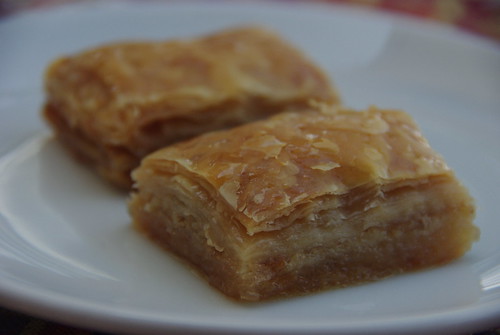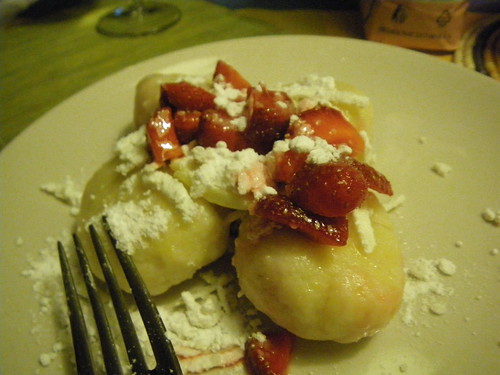Call the dentist! Baklava is probably the only dessert in the world that I can have just one piece and walk away. It’s seriously sweet. A combination of phyllo dough, honey and nuts, baklava is a national dessert here in Turkey. But don’t tell that to the Syrians, Lebanese, Greeks or pretty much anyone else between here and Mongolia who also claim baklava as their own.
 Made in enormous trays, cut and sprinkled with pistachios, baklava is decadently sweet. Ramadan’s evening meal, Iftar, seems to always include dessert. It’s no wonder given how delicious they are here in Turkey, and I swear since Ramadan started I’ve seen more and more Baklava sold on the streets. It is advertised in nearly every shop window, and by late afternoon the smell of baked goods is wafting through the street. Don’t ask me how Muslim’s keep their fast after walking by a pastry shop! Yum!
Made in enormous trays, cut and sprinkled with pistachios, baklava is decadently sweet. Ramadan’s evening meal, Iftar, seems to always include dessert. It’s no wonder given how delicious they are here in Turkey, and I swear since Ramadan started I’ve seen more and more Baklava sold on the streets. It is advertised in nearly every shop window, and by late afternoon the smell of baked goods is wafting through the street. Don’t ask me how Muslim’s keep their fast after walking by a pastry shop! Yum!
Baklava looks like it’s a little intense to prepare, but here’s a recipe that will hopefully make it easier!
Baklava
Ingredients
For the filling:
- 1 (5-inch piece) cinnamon stick, broken into 2/3 pieces or 2 tsp ground
- 15 to 20 whole allspice berries
- 6 ounces blanched almonds
- 6 ounces raw or roasted walnuts
- 6 ounces raw or roasted pistachio
- 2/3 cup sugar
- 1/4 cup water
- 1 teaspoon rose water
- 1 pound phyllo dough, thawed
- 8 ounces clarified unsalted butter, melted
For the syrup:
- 1 1/4 cups honey
- 1 1/4 cups water
- 1 1/4 cups sugar
- 1 cinnamon stick
- 1 (2-inch) piece fresh orange peel
Directions
- Heat the oven to 350 degrees F.
- Place the cinnamon stick and whole allspice into a spice grinder and grind.
- Place the almonds, walnuts, pistachios, sugar and freshly ground spices into the bowl of a food processor and pulse until finely chopped, but not pasty or powdery, approximately 15 quick pulses. Set aside.
- Combine the water and rose water in a small spritz bottle and set aside.
- Trim the sheets of phyllo to fit the bottom of a 13 by 9 by 2-inch metal pan. Brush the bottom and sides of the pan with butter; lay down a sheet of phyllo and brush with butter. Repeat this step 9 more times for a total of 10 sheets of phyllo. Top with 1/3 of the nut mixture and spread thinly. Spritz thoroughly with the rose water. Layer 6 more sheets of phyllo with butter in between each of them, followed by another third of the nuts and spritz with rose water. Repeat with another 6 sheets of phyllo, butter, remaining nuts, and rose water. Top with 8 sheets of phyllo brushing with butter in between each sheet. Brush the top generously with butter. Place in the oven and bake for 30 minutes. Remove pan from the oven and cut into 28 squares. Return pan to the oven and continue to bake for another 30 minutes. Remove pan from the oven, place on a cooling rack, and cool for 2 hours before adding the syrup.
- Make the syrup during the last 30 minutes of cooling. Combine the honey, water, sugar, cinnamon stick and orange peel in a 4-quart saucepan and set over high heat. Stir occasionally until the sugar has dissolved. Once boiling, boil for 10 minutes, stirring occasionally. Remove from the heat and discard the orange peel and cinnamon stick.
- After the baklava has cooled for 2 hours, re-cut the entire pan following the same lines as before. Pour the hot syrup evenly over the top of the baklava, allowing it to run into the cuts and around the edges of the pan. Allow the pan to sit, uncovered until completely cool. Cover and store at room temperature for at least 8 hours and up to overnight before serving. Store, covered, at room temperature for up to 5 days.
Recipe courtesy of The Food Network and Alton Brown, 2008




Recent Comments